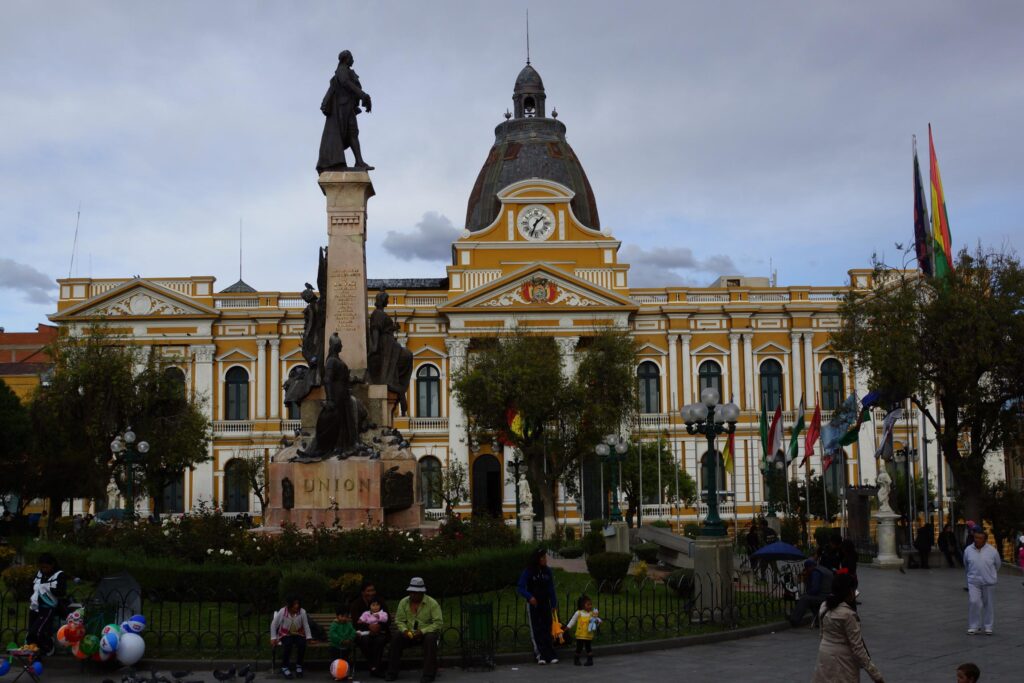La Paz is dizzying in every respect, not only for its well-publicized altitude (3‘360 m). The city is entered via the flat sparse plains of El Alto. The posher suburbs, with skyscrapers, colonial houses and modern glass constructions, occupy the city‘s lower regions. The southern part of La Paz is 800 m lower than El Alto!
Today is another „short“ flying day. Similar to Peru, it was quite a considerable effort to get all the permissions to fly to Bolivia. But we got them a few hours before take-off; Tom and the folks at Jetty, together with some people at Pilatus, did a great job.
During our stay in Cusco, a large helicopter with over a dozen tourists went down not far from us. We run into a lot of policemen from the search team and see the police helicopter that found the wreckage (as we later learn in the news). Obviously the helicopter went down in a snowstorm and nobody survived.
We take off from Cusco and it takes quite some time to gain altitude. But again the pilots do a great job. We fly over the Lago Titicaca, see the hotel we stayed and the floating islands we visited. The lake ends and snow capped mountains begin – and they are spectacular! And so is the approach to La Paz airport – simply one of the most beautiful on this trip so far! We see the beautiful mountains surrounding the city and how it is built in this valley. Since it snowed yesterday, the mountains look even more spectacular.
The airport is not busy at all and the handling is very efficient: fueling, immigration and customs is done within 20 minutes and a van drives us out of the airport gates. We are right in El Alto and now the street starts to descend! The buildigs cling to the sides of the canyon and spill spectacularly downwards. In the background looms the imposing, showy, snowy Mt. Illamani (6‘402 m). Our hotel is on the other end of the city (South side) which means 45 minutes drive and 800 m lower! We are surprised by the many modern buildings and how clean the place is. After checking in, we have lunch at Charley Papa, a burger joint just around the corner. The concept is like TGIF in the States and the food is great. We sit outside and in the sun it is quite hot; in the shadow we put on our sweaters.
We decide to take a cab and explore the city center. The Plaza San Francisco is nothing spectacular and we walk through one of the main shopping streets to Plaza Pedro D. Murillo, where all the important and nice government buildings are. After a while we have seen it, back to the hotel and dinner again at Charley Papa. Everybody is again tired and early to bed.
Famous since Spanish colonial days for its mineral wealth, modern Bolivia was once a part of the ancient Inca empire. After the Spaniards defeated the Incas in the 16th century, Bolivia’s predominantly Indian population was reduced to slavery. The remoteness of the Andes helped protect the Bolivian Indians from the European diseases that decimated other South American Indians. But the existence of a large indigenous group forced to live under the thumb of their colonizers created a stratified society of haves and have-nots that continues to this day. Income inequality between the largely impoverished Indians who make up two-thirds of the country and the light-skinned European elite remains vast.
By the end of the 17th century, the mineral wealth had begun to dry up. The country won its independence in 1825 and was named after Simón Bolívar, the famous liberator. Hampered by internal strife, Bolivia lost great slices of territory to three neighboring nations. Several thousand square miles and its outlet to the Pacific were taken by Chile after the War of the Pacific (1879–1884). In 1903, a piece of Bolivia’s Acre Province, rich in rubber, was ceded to Brazil. And in 1938, after losing the Chaco War of 1932–1935 to Paraguay, Bolivia gave up its claim to nearly 100,000 sq mi of the Gran Chaco. Political instability ensued.
In 1965, a guerrilla movement mounted from Cuba and headed by Maj. Ernesto (Ché) Guevara began a revolutionary war. With the aid of U.S. military advisers, the Bolivian army smashed the guerrilla movement, capturing and killing Guevara on Oct. 8, 1967. A string of military coups followed before the military returned the government to civilian rule in 1982. At that point, Bolivia was regularly shut down by work stoppages and had the lowest per capita income in South America.
In August 1997, former general Hugo Bánzer, an ex-dictator turned democrat became president for the second time. Bánzer made significant progress in wiping out illicit coca production and drug trafficking, which pleased the United States. However, the eradication of coca, a major crop in Bolivia since Incan times, plunged many Bolivian farmers into abject poverty. Although Bolivia sits on South America’s second-largest natural gas reserves as well as considerable oil, the country has remained one of the poorest on the continent.
